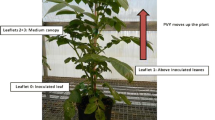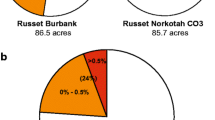Abstract
Studies were performed to investigate factors affecting symptom expression of potato virus Y infection in three potato cultivars, Russet Norkotah, Shepody, and Red LaSoda. Quantitative enzyme-linked immunosorbent assay (ELISA) results revealed few differences in the relative virus titer among cultivars tested. Potato virus Y (PVY) titers developed as rapidly in Russet Norkotah as in Shepody and Red LaSoda. Additional studies were performed to determine the effect of light intensity and infections of PVY and potato virus X (PVX), alone and in combination, on the expression of mosaic symptoms in these three cultivars. Low light intensity (270-330 uE/m2/sec) significantly increased plant heights and severity of mosaic disease among the cultivars compared to high light intensity (100-200 uE/m2/sec). PVX and PVY, as well as the combination of PVX and PVY in the same plant, decreased plant height compared to the uninoculated (healthy) controls. Low light intensity and dual infections of PVX and PVY significantly increased mosaic disease severity in Shepody and Red LaSoda, but not in Russet Norkotah. Results of these studies refute the suggestion that Russet Norkotah is resistant to PVY infection since virus titers in this cultivar are similar to the known susceptible cultivars Shepody and Red LaSoda. These results further suggest that while Russet Norkotah is fully susceptible to infection by PVY, it resists symptom expression.
Resumen
Este estudio se realizó con el fin de investigar los factores que afectan la expresión de los síntomas del virus Y de la papa en tres cultivares, Russet Norkotah, Shepody y Red LaSoda. Los resultados del ensayo inmunoabsorbente ligado a la enzima cuantitativa (ELISA) revelaron algunas diferencias en el título relacionado del virus entre los cultivares examinados. El título del virus Y de la papa (PVY) se desarrolló rápidamente tanto en el cv. Russet Norkotah como en los cvs. Shepody y Red LaSoda. Se realizaron estudios adicionales para determinar los efectos de la intensidad de la luz y de las infecciones de PVY y del virus X (PVX), solos y en combinación, sobre la expresión de los síntomas del mosaico en esos tres cultivares. La baja intensidad de la luz (270–330 uE/m2/sec) incrementó significativamente la altura de la planta y la severidad de la enfermedad del mosaico entre los cultivares en comparación con la alta intensidad de la luz (100–200 uE/m2/sec). La presencia de PVX y PVY así como la combinación de ambos en la misma planta, redujo la altura de la planta en comparación con los controles no inoculados (sanos). La baja intensidad de la luz y la infección dual de PVX y PVY incrementaron significativamente la severidad de la enfermedad del mosaico en los cvs. Shepody y Red LaSoda, pero no en el cv. Russet Norkotah. Los resultados del estudio refutan la sugerencia de que Russet Norkotah es resistente a la infección del PVY, ya que el título del virus de este cultivar es similar a los cultivares de Shepody y Red Lasoda de susceptibilidad conocida. Estos resultados sugieren ampliamente que mientras el cv. Russet Norkotah es altamente susceptible a la infección por PVY, es resistente a la expresión de los síntomas.
Similar content being viewed by others
Literature Cited
Bagnall, R.H., and G.C.C. Tai. 1986. Field resistance to potato virus Y in potato assessed by cluster analysis. Plant Dis 70: 301–304.
Banik, M.T., and T.A. Zitter. 1990. Determination of cucumber mosaic virus titer in muskmelon by enzyme linked immunosorbent assay and correlation with aphid transmission. Plant Dis 74: 857–859.
Beemster, A.B.R., and J.A. deBokx. 1987. Potato virus X (a potexvirus).In: Viruses of Potato and Seed Potato Production, 2nd ed. Pudoc, Wageningen, Netherlands. 259 pp.
Clarke, R.G. 1995. Director of seed potato certification. Idaho Crop Improvement Association. Personal communication.
Cooper, J.I., and A.T. Jones. 1983. Responses of plants to viruses: Proposal for the use of terms. Phytopathology 73: 127–128.
deBokx, J.A., and H. Huttinga. 1981. Potato virus Y, No. 242 (No. 37 revised) In: Descriptions of Plant Viruses. CM I/AAB New Surrey, England.
Hane, D.C., and P.B. Hamm. 1999. Effects of seedborne potato virus Y infection in two potato cultivars expressing mild disease symptoms. Plant Dis 83: 4345.
Helms, K., W.J. Muller, and P.M. Waterhouse. 1987. Subterranean clover red leaf virus disease: Effects of light intensity on plant symptoms, growth and virus content. Phytopathology 77: 1297–1300.
Henn, R.A., J.G. Phillips, and R.G. Brown. 1995. Russet Norkotah; A potato cultivar latently infected by PVYo. Am Potato J 72: 629–630 (Abst).
Hewings, A.D., V.D. Damsteegt, A.E. Sindermann, and S.A. Tolin. 1990. Variations in serologically detectable antigen of Soybean Dwarf Virus in soybean leaflets as a function of time after inoculation and plant age. Plant Dis 74: 844–848.
Jensen, S.G., M.K. Palomar, E.M. Ball, and R. Samson. 1985. Factors influencing virus titer in maize dwarf mosaic virus infected sorghum. Phytopathology 75: 1132–1136.
Johansen, R.J., B. Farnsworth, D.C. Nelson, G.A. Secor, N. Gudmestad, and P.H. Orr. 1988. Russet Norkotah: A new russet-skinned potato with wide adaptation. Am Potato J 65: 597–604.
Lapidot, M., I. Paran, R. Ben-Joseph, S. Ben-Harush, M. Pilowsky, S. Cohen, and C. Shifriss. 1997. Tolerance to cucumber mosaic virus in pepper: Development of advanced breeding Unes and evaluation of virus level. Plant Dis 81: 185–188.
Matthews, R.E.F. 1991. Transmission, Movement, and Host Range.In: Plant Virology, 3rd ed. Academic Press, New York. pp. 338–378.
Maule, A.J. 1991. Virus movement in infected plants. Crit Rev Plant Sci 9: 457–473.
Mehdizadegan, F., and T. Bourgoin, 1994. Relationships between mosaic symptom expression in field infection by PVM, PVS, PVX, and PVY in variety Shepody. Am Potato J 71: 687–688 (Abst).
Peterschmitt, M., J.B. Quiot, B. Reynaud, and P. Baudin. 1992. Detection of maize streak virus antigens over time in different parts of maize plants of a sensitive and so-called tolerant cultivar by ELISA. Ann Appl Biol 121: 642–653.
Pink, D.A., and D.G.A. Walkey. 1985. Effect of temperature and light intensity on resistance in Marrow (Cucurbita pepo) to cucumber mosaic virus. J Agric Sci 104: 325–329.
Putnam, C. 1990. First catch your aphid then blend it. New Scientist 127: 62.
Qiu, S.G., and J.E. Schoelz. 1992. Three regions of cauliflower mosaic virus strain W260 are involved in systemic infection of solanaceous hosts. Virology 190: 773–782.
Ranieri, R., R.M. Lister, and P.A. Burnett. 1993. Relationships between barley yellow dwarf virus titer and symptom expression in barley. Crop Sci 33: 968–973.
Secor, G.A., R. Johansen, and N.C. Gudmestad. 1983. Update on virus Y infection in ND534-4 Russ Valley Potato Grower 48: 26–27.
Seifers, D.L., and T.J. Martin. 1988. Correlation of low level wheat streak mosaic virus resistance in Triumph 64 wheat with low virus titer. Phytopathology 78: 703–707.
Shepard, J.F., G.A. Secor, and D.E. Purcifull. 1974. Immunochemical cross-reactivity between the dissociated capsid proteins of PVY group plant viruses. Virology 58: 464–475.
Singh, R.P., S.M.P. Khurana, B.B. Nagaich, and H.O. Agrawal. 1988. Environmental factors influencing aphid transmission of potato virus Y and leafroll virus. Potato Res 31: 501–509.
Singh, R.P., and T.H. Somerville. 1987. Relationship of virus concentration with the field resistance to potato virus Y in potatoes. Am Potato J 65: 163–165.
White, R.F., and J.F. Antoniw. 1991. Virus-induced resistance responses in plants. Crit Rev Plant Sci 9: 443–455.
Whitehead, T. 1937. Virus diseases of potato. The “carrier” problem. Its relation to symptomatology and commercial potato growing. Ann Appl Biol 24: 323–341.
Young, DA, Tarn, T.R., and Davies, H.T. 1983. Shepody: A long, smooth, white-skinned potato of medium maturity with excellent french fry quality. Am Potato J 60: 109–113.
Author information
Authors and Affiliations
Corresponding author
Rights and permissions
About this article
Cite this article
Draper, M.D., Pasche, J.S. & Gudmestad, N.C. Factors influencing PVY development and disease expression in three potato cultivars. Am. J. Pot Res 79, 155–165 (2002). https://doi.org/10.1007/BF02871931
Accepted:
Issue Date:
DOI: https://doi.org/10.1007/BF02871931




